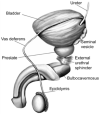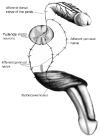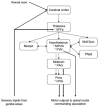Normal male sexual function: emphasis on orgasm and ejaculation
- PMID: 26385403
- PMCID: PMC4896089
- DOI: 10.1016/j.fertnstert.2015.08.033
Normal male sexual function: emphasis on orgasm and ejaculation
Abstract
Orgasm and ejaculation are two separate physiological processes that are sometimes difficult to distinguish. Orgasm is an intense transient peak sensation of intense pleasure creating an altered state of consciousness associated with reported physical changes. Antegrade ejaculation is a complex physiological process that is composed of two phases (emission and expulsion), and is influenced by intricate neurological and hormonal pathways. Despite the many published research projects dealing with the physiology of orgasm and ejaculation, much about this topic is still unknown. Ejaculatory dysfunction is a common disorder, and currently has no definitive cure. Understanding the complex physiology of orgasm and ejaculation allows the development of therapeutic targets for ejaculatory dysfunction. In this article, we summarize the current literature on the physiology of orgasm and ejaculation, starting with a brief description of the anatomy of sex organs and the physiology of erection. Then, we describe the physiology of orgasm and ejaculation detailing the neuronal, neurochemical, and hormonal control of the ejaculation process.
Keywords: Erectile function; ejaculation; male sexual function; orgasm.
Copyright © 2015 American Society for Reproductive Medicine. Published by Elsevier Inc. All rights reserved.
Figures



References
-
- Sheu G, Revenig LM, Hsiao W. Physiology of ejaculation. In: Mulhall JP, Hsiao W, editors. Men's sexual health and fertility. Springer Science; New York: 2014. pp. 13–29.
-
- Bella AJ, Shamloul R. Functional anatomy of the male sex organs. In: Mulhall JP, Incocci L, Goldstein I, Rosen R, editors. Cancer and sexual health. Springer Science; New York: 2011. pp. 3–12.
-
- Meacham R, Lipshultz L, Howards S. Male infertility. In: Gillenwater JY, Grayhack JT, Howards S, Duckett JW, editors. Adult and pediatric urology. Mosby; St. Louis: 1996. pp. 1747–802.
-
- Hinman F. Normal surgical anatomy. In: Thomas Thomas AJ, Nagler HN, editors. Atlas of surgical management of male infertility. William & Wilkins; New York: 1995. pp. 9–20.
-
- Romanes G. The pelvis and perineum. In: Romanes G, Cunningham D, editors. Cunningham's manual of practical anatomy. 13th ed Oxford University Press; London, UK: 1975. pp. 199–240.
Publication types
MeSH terms
Substances
Grants and funding
LinkOut - more resources
Full Text Sources
Other Literature Sources
Medical

